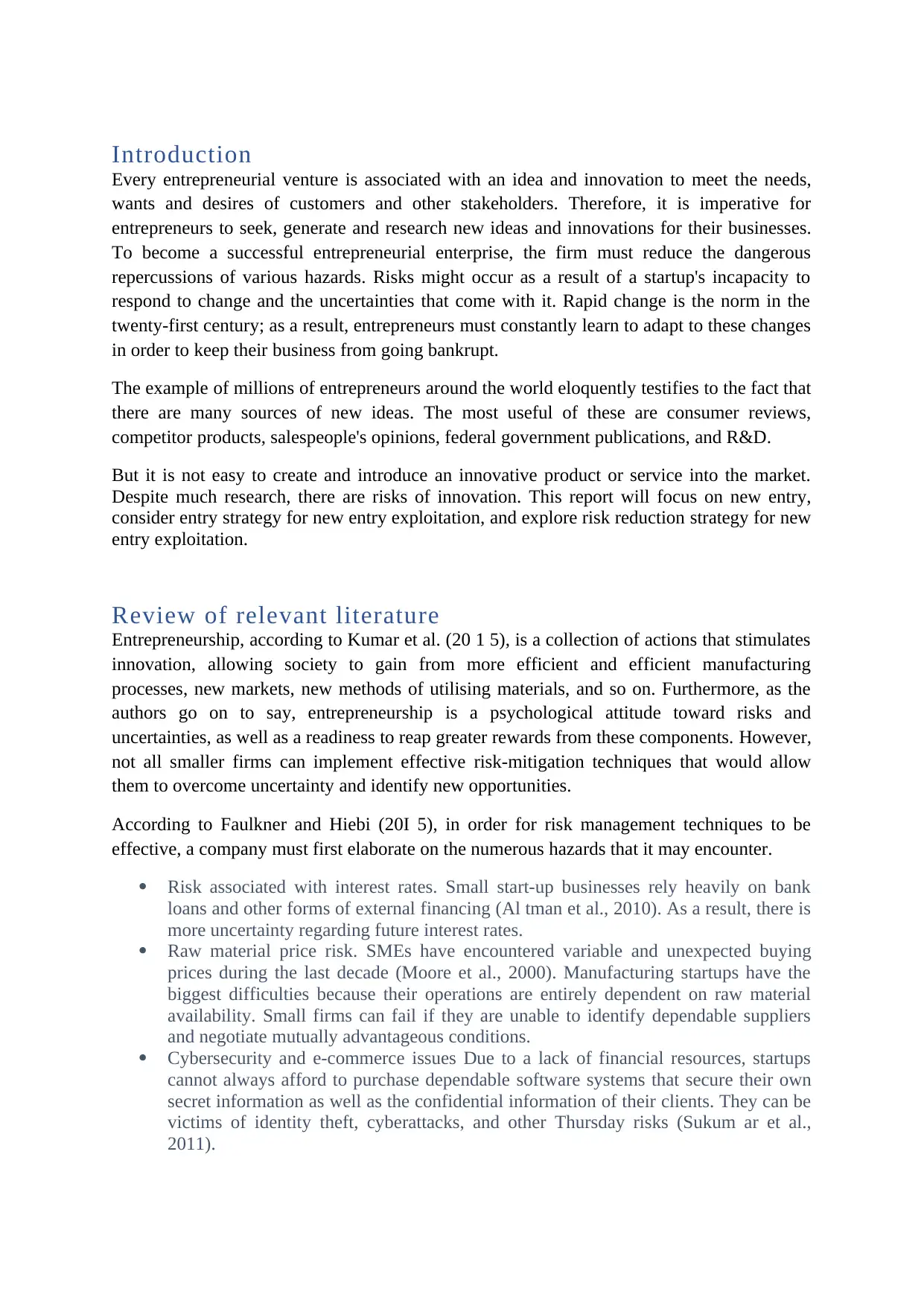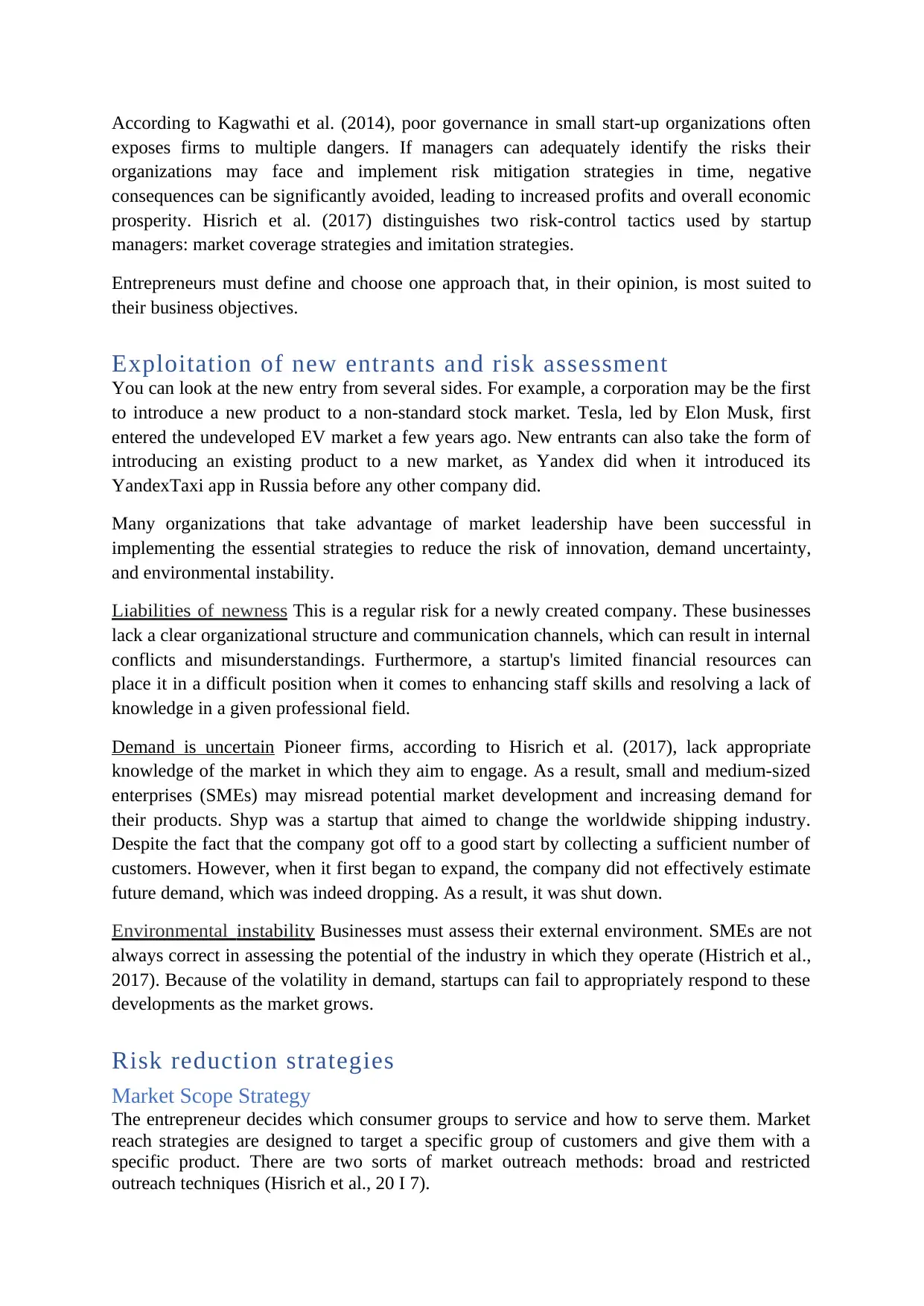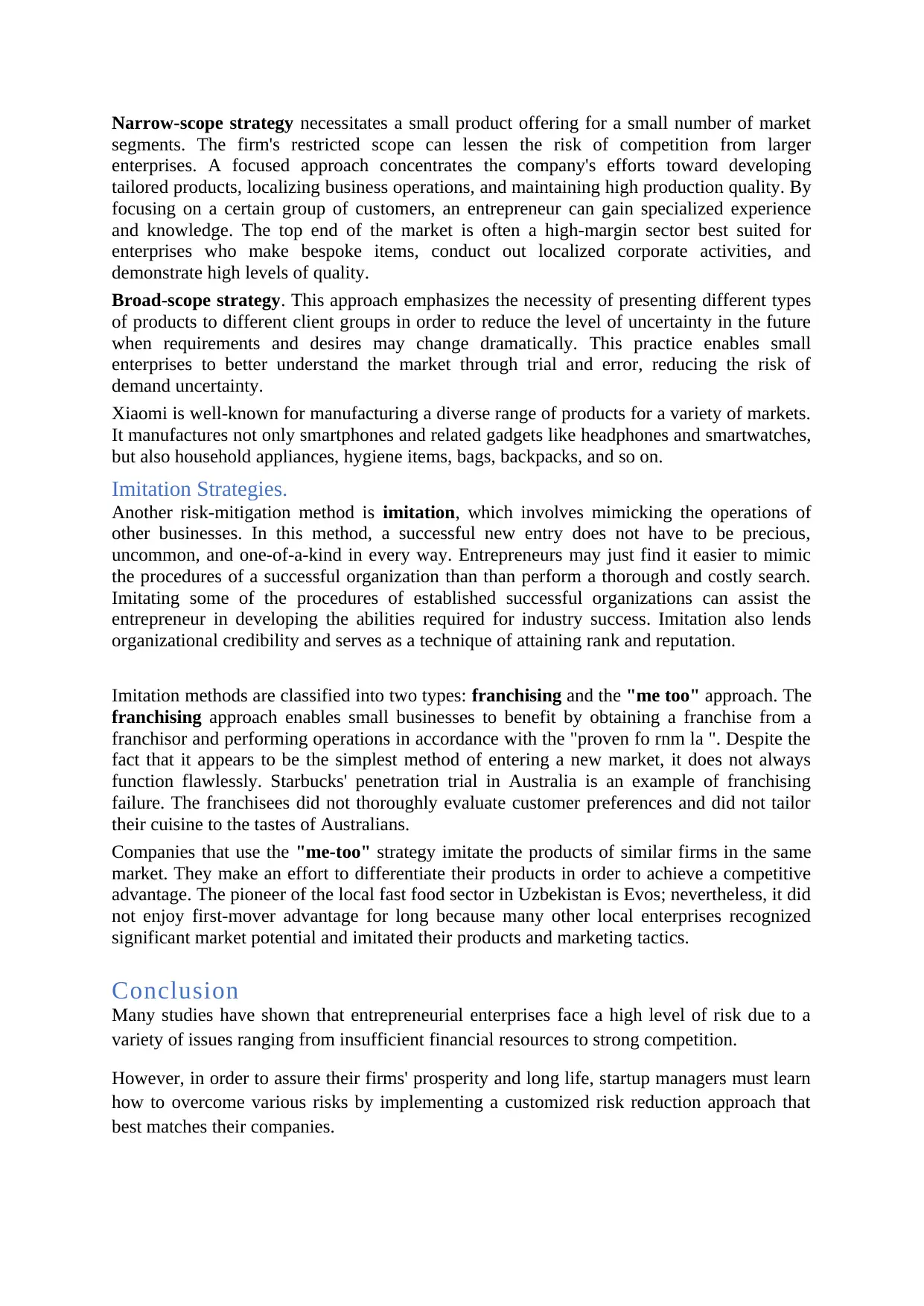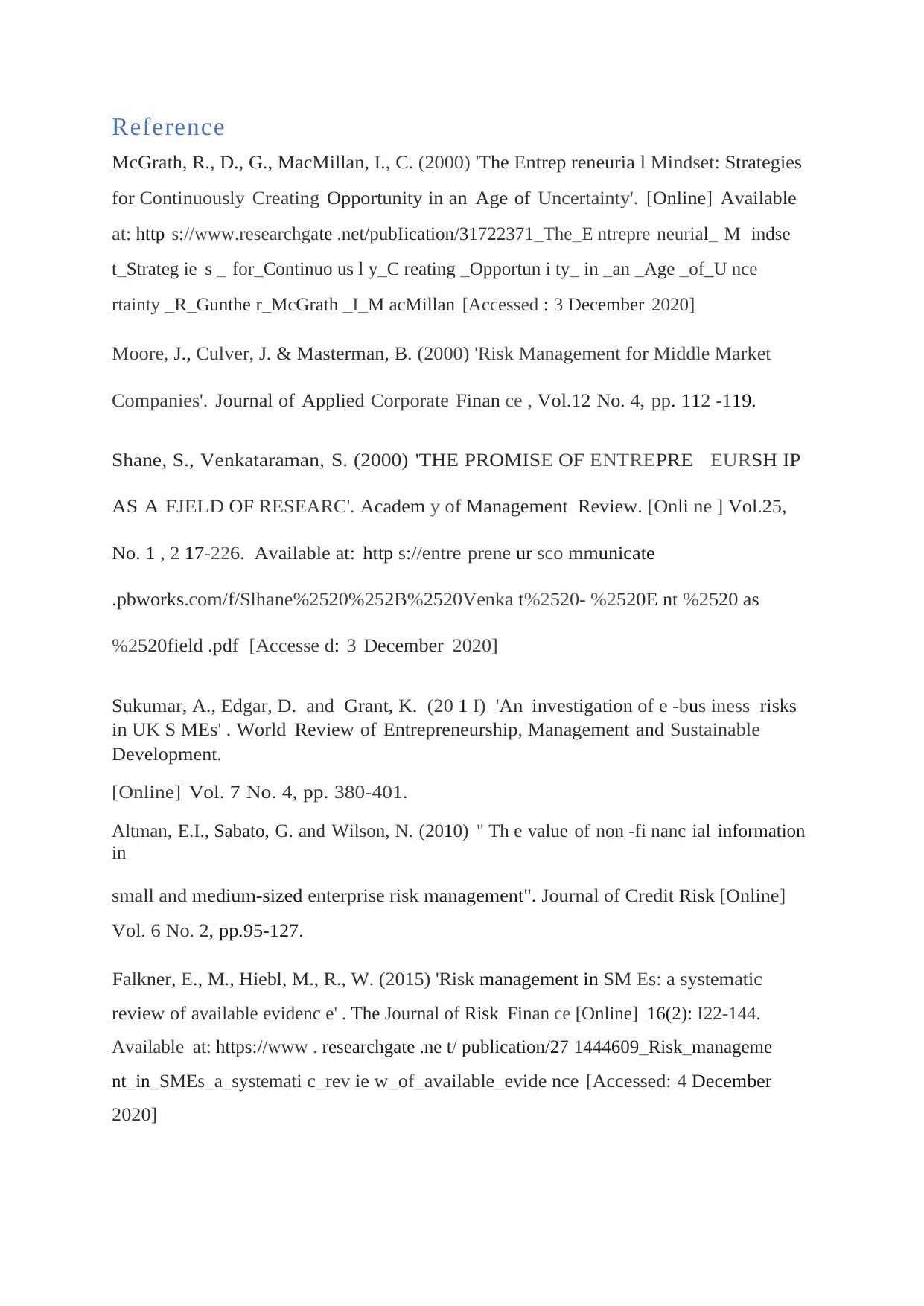The Role of Innovation in Entrepreneurship
VerifiedAdded on 2022/01/17
|4
|1978
|291
AI Summary
Rapid change is the norm in the twenty-first century; as a result, entrepreneurs must constantly learn to adapt to these changes in order to keep their business from going bankrupt. This report will focus on new entry, consider entry strategy for new entry exploitation, and explore risk reduction strategy for new entry exploitation. According to Faulkner and Hiebi (20I 5), in order for risk management techniques to be effective, a company must first elaborate on the numerous hazards that it may encounter.
Contribute Materials
Your contribution can guide someone’s learning journey. Share your
documents today.

Introduction
Every entrepreneurial venture is associated with an idea and innovation to meet the needs,
wants and desires of customers and other stakeholders. Therefore, it is imperative for
entrepreneurs to seek, generate and research new ideas and innovations for their businesses.
To become a successful entrepreneurial enterprise, the firm must reduce the dangerous
repercussions of various hazards. Risks might occur as a result of a startup's incapacity to
respond to change and the uncertainties that come with it. Rapid change is the norm in the
twenty-first century; as a result, entrepreneurs must constantly learn to adapt to these changes
in order to keep their business from going bankrupt.
The example of millions of entrepreneurs around the world eloquently testifies to the fact that
there are many sources of new ideas. The most useful of these are consumer reviews,
competitor products, salespeople's opinions, federal government publications, and R&D.
But it is not easy to create and introduce an innovative product or service into the market.
Despite much research, there are risks of innovation. This report will focus on new entry,
consider entry strategy for new entry exploitation, and explore risk reduction strategy for new
entry exploitation.
Review of relevant literature
Entrepreneurship, according to Kumar et al. (20 1 5), is a collection of actions that stimulates
innovation, allowing society to gain from more efficient and efficient manufacturing
processes, new markets, new methods of utilising materials, and so on. Furthermore, as the
authors go on to say, entrepreneurship is a psychological attitude toward risks and
uncertainties, as well as a readiness to reap greater rewards from these components. However,
not all smaller firms can implement effective risk-mitigation techniques that would allow
them to overcome uncertainty and identify new opportunities.
According to Faulkner and Hiebi (20I 5), in order for risk management techniques to be
effective, a company must first elaborate on the numerous hazards that it may encounter.
Risk associated with interest rates. Small start-up businesses rely heavily on bank
loans and other forms of external financing (Al tman et al., 2010). As a result, there is
more uncertainty regarding future interest rates.
Raw material price risk. SMEs have encountered variable and unexpected buying
prices during the last decade (Moore et al., 2000). Manufacturing startups have the
biggest difficulties because their operations are entirely dependent on raw material
availability. Small firms can fail if they are unable to identify dependable suppliers
and negotiate mutually advantageous conditions.
Cybersecurity and e-commerce issues Due to a lack of financial resources, startups
cannot always afford to purchase dependable software systems that secure their own
secret information as well as the confidential information of their clients. They can be
victims of identity theft, cyberattacks, and other Thursday risks (Sukum ar et al.,
2011).
Every entrepreneurial venture is associated with an idea and innovation to meet the needs,
wants and desires of customers and other stakeholders. Therefore, it is imperative for
entrepreneurs to seek, generate and research new ideas and innovations for their businesses.
To become a successful entrepreneurial enterprise, the firm must reduce the dangerous
repercussions of various hazards. Risks might occur as a result of a startup's incapacity to
respond to change and the uncertainties that come with it. Rapid change is the norm in the
twenty-first century; as a result, entrepreneurs must constantly learn to adapt to these changes
in order to keep their business from going bankrupt.
The example of millions of entrepreneurs around the world eloquently testifies to the fact that
there are many sources of new ideas. The most useful of these are consumer reviews,
competitor products, salespeople's opinions, federal government publications, and R&D.
But it is not easy to create and introduce an innovative product or service into the market.
Despite much research, there are risks of innovation. This report will focus on new entry,
consider entry strategy for new entry exploitation, and explore risk reduction strategy for new
entry exploitation.
Review of relevant literature
Entrepreneurship, according to Kumar et al. (20 1 5), is a collection of actions that stimulates
innovation, allowing society to gain from more efficient and efficient manufacturing
processes, new markets, new methods of utilising materials, and so on. Furthermore, as the
authors go on to say, entrepreneurship is a psychological attitude toward risks and
uncertainties, as well as a readiness to reap greater rewards from these components. However,
not all smaller firms can implement effective risk-mitigation techniques that would allow
them to overcome uncertainty and identify new opportunities.
According to Faulkner and Hiebi (20I 5), in order for risk management techniques to be
effective, a company must first elaborate on the numerous hazards that it may encounter.
Risk associated with interest rates. Small start-up businesses rely heavily on bank
loans and other forms of external financing (Al tman et al., 2010). As a result, there is
more uncertainty regarding future interest rates.
Raw material price risk. SMEs have encountered variable and unexpected buying
prices during the last decade (Moore et al., 2000). Manufacturing startups have the
biggest difficulties because their operations are entirely dependent on raw material
availability. Small firms can fail if they are unable to identify dependable suppliers
and negotiate mutually advantageous conditions.
Cybersecurity and e-commerce issues Due to a lack of financial resources, startups
cannot always afford to purchase dependable software systems that secure their own
secret information as well as the confidential information of their clients. They can be
victims of identity theft, cyberattacks, and other Thursday risks (Sukum ar et al.,
2011).
Secure Best Marks with AI Grader
Need help grading? Try our AI Grader for instant feedback on your assignments.

According to Kagwathi et al. (2014), poor governance in small start-up organizations often
exposes firms to multiple dangers. If managers can adequately identify the risks their
organizations may face and implement risk mitigation strategies in time, negative
consequences can be significantly avoided, leading to increased profits and overall economic
prosperity. Hisrich et al. (2017) distinguishes two risk-control tactics used by startup
managers: market coverage strategies and imitation strategies.
Entrepreneurs must define and choose one approach that, in their opinion, is most suited to
their business objectives.
Exploitation of new entrants and risk assessment
You can look at the new entry from several sides. For example, a corporation may be the first
to introduce a new product to a non-standard stock market. Tesla, led by Elon Musk, first
entered the undeveloped EV market a few years ago. New entrants can also take the form of
introducing an existing product to a new market, as Yandex did when it introduced its
YandexTaxi app in Russia before any other company did.
Many organizations that take advantage of market leadership have been successful in
implementing the essential strategies to reduce the risk of innovation, demand uncertainty,
and environmental instability.
Liabilities of newness This is a regular risk for a newly created company. These businesses
lack a clear organizational structure and communication channels, which can result in internal
conflicts and misunderstandings. Furthermore, a startup's limited financial resources can
place it in a difficult position when it comes to enhancing staff skills and resolving a lack of
knowledge in a given professional field.
Demand is uncertain Pioneer firms, according to Hisrich et al. (2017), lack appropriate
knowledge of the market in which they aim to engage. As a result, small and medium-sized
enterprises (SMEs) may misread potential market development and increasing demand for
their products. Shyp was a startup that aimed to change the worldwide shipping industry.
Despite the fact that the company got off to a good start by collecting a sufficient number of
customers. However, when it first began to expand, the company did not effectively estimate
future demand, which was indeed dropping. As a result, it was shut down.
Environmental instability Businesses must assess their external environment. SMEs are not
always correct in assessing the potential of the industry in which they operate (Histrich et al.,
2017). Because of the volatility in demand, startups can fail to appropriately respond to these
developments as the market grows.
Risk reduction strategies
Market Scope Strategy
The entrepreneur decides which consumer groups to service and how to serve them. Market
reach strategies are designed to target a specific group of customers and give them with a
specific product. There are two sorts of market outreach methods: broad and restricted
outreach techniques (Hisrich et al., 20 I 7).
exposes firms to multiple dangers. If managers can adequately identify the risks their
organizations may face and implement risk mitigation strategies in time, negative
consequences can be significantly avoided, leading to increased profits and overall economic
prosperity. Hisrich et al. (2017) distinguishes two risk-control tactics used by startup
managers: market coverage strategies and imitation strategies.
Entrepreneurs must define and choose one approach that, in their opinion, is most suited to
their business objectives.
Exploitation of new entrants and risk assessment
You can look at the new entry from several sides. For example, a corporation may be the first
to introduce a new product to a non-standard stock market. Tesla, led by Elon Musk, first
entered the undeveloped EV market a few years ago. New entrants can also take the form of
introducing an existing product to a new market, as Yandex did when it introduced its
YandexTaxi app in Russia before any other company did.
Many organizations that take advantage of market leadership have been successful in
implementing the essential strategies to reduce the risk of innovation, demand uncertainty,
and environmental instability.
Liabilities of newness This is a regular risk for a newly created company. These businesses
lack a clear organizational structure and communication channels, which can result in internal
conflicts and misunderstandings. Furthermore, a startup's limited financial resources can
place it in a difficult position when it comes to enhancing staff skills and resolving a lack of
knowledge in a given professional field.
Demand is uncertain Pioneer firms, according to Hisrich et al. (2017), lack appropriate
knowledge of the market in which they aim to engage. As a result, small and medium-sized
enterprises (SMEs) may misread potential market development and increasing demand for
their products. Shyp was a startup that aimed to change the worldwide shipping industry.
Despite the fact that the company got off to a good start by collecting a sufficient number of
customers. However, when it first began to expand, the company did not effectively estimate
future demand, which was indeed dropping. As a result, it was shut down.
Environmental instability Businesses must assess their external environment. SMEs are not
always correct in assessing the potential of the industry in which they operate (Histrich et al.,
2017). Because of the volatility in demand, startups can fail to appropriately respond to these
developments as the market grows.
Risk reduction strategies
Market Scope Strategy
The entrepreneur decides which consumer groups to service and how to serve them. Market
reach strategies are designed to target a specific group of customers and give them with a
specific product. There are two sorts of market outreach methods: broad and restricted
outreach techniques (Hisrich et al., 20 I 7).

Narrow-scope strategy necessitates a small product offering for a small number of market
segments. The firm's restricted scope can lessen the risk of competition from larger
enterprises. A focused approach concentrates the company's efforts toward developing
tailored products, localizing business operations, and maintaining high production quality. By
focusing on a certain group of customers, an entrepreneur can gain specialized experience
and knowledge. The top end of the market is often a high-margin sector best suited for
enterprises who make bespoke items, conduct out localized corporate activities, and
demonstrate high levels of quality.
Broad-scope strategy. This approach emphasizes the necessity of presenting different types
of products to different client groups in order to reduce the level of uncertainty in the future
when requirements and desires may change dramatically. This practice enables small
enterprises to better understand the market through trial and error, reducing the risk of
demand uncertainty.
Xiaomi is well-known for manufacturing a diverse range of products for a variety of markets.
It manufactures not only smartphones and related gadgets like headphones and smartwatches,
but also household appliances, hygiene items, bags, backpacks, and so on.
Imitation Strategies.
Another risk-mitigation method is imitation, which involves mimicking the operations of
other businesses. In this method, a successful new entry does not have to be precious,
uncommon, and one-of-a-kind in every way. Entrepreneurs may just find it easier to mimic
the procedures of a successful organization than than perform a thorough and costly search.
Imitating some of the procedures of established successful organizations can assist the
entrepreneur in developing the abilities required for industry success. Imitation also lends
organizational credibility and serves as a technique of attaining rank and reputation.
Imitation methods are classified into two types: franchising and the "me too" approach. The
franchising approach enables small businesses to benefit by obtaining a franchise from a
franchisor and performing operations in accordance with the "proven fo rnm la ". Despite the
fact that it appears to be the simplest method of entering a new market, it does not always
function flawlessly. Starbucks' penetration trial in Australia is an example of franchising
failure. The franchisees did not thoroughly evaluate customer preferences and did not tailor
their cuisine to the tastes of Australians.
Companies that use the "me-too" strategy imitate the products of similar firms in the same
market. They make an effort to differentiate their products in order to achieve a competitive
advantage. The pioneer of the local fast food sector in Uzbekistan is Evos; nevertheless, it did
not enjoy first-mover advantage for long because many other local enterprises recognized
significant market potential and imitated their products and marketing tactics.
Conclusion
Many studies have shown that entrepreneurial enterprises face a high level of risk due to a
variety of issues ranging from insufficient financial resources to strong competition.
However, in order to assure their firms' prosperity and long life, startup managers must learn
how to overcome various risks by implementing a customized risk reduction approach that
best matches their companies.
segments. The firm's restricted scope can lessen the risk of competition from larger
enterprises. A focused approach concentrates the company's efforts toward developing
tailored products, localizing business operations, and maintaining high production quality. By
focusing on a certain group of customers, an entrepreneur can gain specialized experience
and knowledge. The top end of the market is often a high-margin sector best suited for
enterprises who make bespoke items, conduct out localized corporate activities, and
demonstrate high levels of quality.
Broad-scope strategy. This approach emphasizes the necessity of presenting different types
of products to different client groups in order to reduce the level of uncertainty in the future
when requirements and desires may change dramatically. This practice enables small
enterprises to better understand the market through trial and error, reducing the risk of
demand uncertainty.
Xiaomi is well-known for manufacturing a diverse range of products for a variety of markets.
It manufactures not only smartphones and related gadgets like headphones and smartwatches,
but also household appliances, hygiene items, bags, backpacks, and so on.
Imitation Strategies.
Another risk-mitigation method is imitation, which involves mimicking the operations of
other businesses. In this method, a successful new entry does not have to be precious,
uncommon, and one-of-a-kind in every way. Entrepreneurs may just find it easier to mimic
the procedures of a successful organization than than perform a thorough and costly search.
Imitating some of the procedures of established successful organizations can assist the
entrepreneur in developing the abilities required for industry success. Imitation also lends
organizational credibility and serves as a technique of attaining rank and reputation.
Imitation methods are classified into two types: franchising and the "me too" approach. The
franchising approach enables small businesses to benefit by obtaining a franchise from a
franchisor and performing operations in accordance with the "proven fo rnm la ". Despite the
fact that it appears to be the simplest method of entering a new market, it does not always
function flawlessly. Starbucks' penetration trial in Australia is an example of franchising
failure. The franchisees did not thoroughly evaluate customer preferences and did not tailor
their cuisine to the tastes of Australians.
Companies that use the "me-too" strategy imitate the products of similar firms in the same
market. They make an effort to differentiate their products in order to achieve a competitive
advantage. The pioneer of the local fast food sector in Uzbekistan is Evos; nevertheless, it did
not enjoy first-mover advantage for long because many other local enterprises recognized
significant market potential and imitated their products and marketing tactics.
Conclusion
Many studies have shown that entrepreneurial enterprises face a high level of risk due to a
variety of issues ranging from insufficient financial resources to strong competition.
However, in order to assure their firms' prosperity and long life, startup managers must learn
how to overcome various risks by implementing a customized risk reduction approach that
best matches their companies.

Reference
McGrath, R., D., G., MacMillan, I., C. (2000) 'The Entrep reneuria l Mindset: Strategies
for Continuously Creating Opportunity in an Age of Uncertainty'. [Online] Available
at: http s://www.researchgate .net/pubIication/31722371_The_E ntrepre neurial_ M indse
t_Strateg ie s _ for_Continuo us l y_C reating _Opportun i ty_ in _an _Age _of_U nce
rtainty _R_Gunthe r_McGrath _I_M acMillan [Accessed : 3 December 2020]
Moore, J., Culver, J. & Masterman, B. (2000) 'Risk Management for Middle Market
Companies'. Journal of Applied Corporate Finan ce , Vol.12 No. 4, pp. 112 -119.
Shane, S., Venkataraman, S. (2000) 'THE PROMISE OF ENTREPRE EURSH IP
AS A FJELD OF RESEARC'. Academ y of Management Review. [Onli ne ] Vol.25,
No. 1 , 2 17-226. Available at: http s://entre prene ur sco mmunicate
.pbworks.com/f/Slhane%2520%252B%2520Venka t%2520- %2520E nt %2520 as
%2520field .pdf [Accesse d: 3 December 2020]
Sukumar, A., Edgar, D. and Grant, K. (20 1 I) 'An investigation of e -bus iness risks
in UK S MEs' . World Review of Entrepreneurship, Management and Sustainable
Development.
[Online] Vol. 7 No. 4, pp. 380-401.
Altman, E.I., Sabato, G. and Wilson, N. (2010) " Th e value of non -fi nanc ial information
in
small and medium-sized enterprise risk management". Journal of Credit Risk [Online]
Vol. 6 No. 2, pp.95-127.
Falkner, E., M., Hiebl, M., R., W. (2015) 'Risk management in SM Es: a systematic
review of available evidenc e' . The Journal of Risk Finan ce [Online] 16(2): I22-144.
Available at: https://www . researchgate .ne t/ publication/27 1444609_Risk_manageme
nt_in_SMEs_a_systemati c_rev ie w_of_available_evide nce [Accessed: 4 December
2020]
McGrath, R., D., G., MacMillan, I., C. (2000) 'The Entrep reneuria l Mindset: Strategies
for Continuously Creating Opportunity in an Age of Uncertainty'. [Online] Available
at: http s://www.researchgate .net/pubIication/31722371_The_E ntrepre neurial_ M indse
t_Strateg ie s _ for_Continuo us l y_C reating _Opportun i ty_ in _an _Age _of_U nce
rtainty _R_Gunthe r_McGrath _I_M acMillan [Accessed : 3 December 2020]
Moore, J., Culver, J. & Masterman, B. (2000) 'Risk Management for Middle Market
Companies'. Journal of Applied Corporate Finan ce , Vol.12 No. 4, pp. 112 -119.
Shane, S., Venkataraman, S. (2000) 'THE PROMISE OF ENTREPRE EURSH IP
AS A FJELD OF RESEARC'. Academ y of Management Review. [Onli ne ] Vol.25,
No. 1 , 2 17-226. Available at: http s://entre prene ur sco mmunicate
.pbworks.com/f/Slhane%2520%252B%2520Venka t%2520- %2520E nt %2520 as
%2520field .pdf [Accesse d: 3 December 2020]
Sukumar, A., Edgar, D. and Grant, K. (20 1 I) 'An investigation of e -bus iness risks
in UK S MEs' . World Review of Entrepreneurship, Management and Sustainable
Development.
[Online] Vol. 7 No. 4, pp. 380-401.
Altman, E.I., Sabato, G. and Wilson, N. (2010) " Th e value of non -fi nanc ial information
in
small and medium-sized enterprise risk management". Journal of Credit Risk [Online]
Vol. 6 No. 2, pp.95-127.
Falkner, E., M., Hiebl, M., R., W. (2015) 'Risk management in SM Es: a systematic
review of available evidenc e' . The Journal of Risk Finan ce [Online] 16(2): I22-144.
Available at: https://www . researchgate .ne t/ publication/27 1444609_Risk_manageme
nt_in_SMEs_a_systemati c_rev ie w_of_available_evide nce [Accessed: 4 December
2020]
1 out of 4
Related Documents
Your All-in-One AI-Powered Toolkit for Academic Success.
+13062052269
info@desklib.com
Available 24*7 on WhatsApp / Email
![[object Object]](/_next/static/media/star-bottom.7253800d.svg)
Unlock your academic potential
© 2024 | Zucol Services PVT LTD | All rights reserved.





